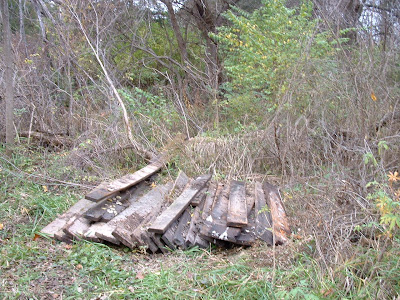A week ago the pond froze over in a genuinely hard freeze. The next morning it was 12℉ at 6:30 a.m. I took my walk in perfectly still air, and so dry that no frost had formed on the ground. Up by the meditation bench, an enormous branch from a big dead tree had fallen to shatter across the trail. There was no wind, so I wonder if moisture inside cracks froze and burst the wood fibers, splitting a third of the tree away from the trunk. Once I get to it, I reckon there will be enough firewood to fill the new wagon three times.
This poor ornamental maple is on a game trail where it crosses the lane and has been severely "buck rubbed" by male deer. They're marking territory, or maybe their growing antlers irritate them. I'll be surprised if the tree survives. The deer do a lot of damage and this is one of our greatest concerns as we prepare to plant the first acre of apple orchard. Everything we read and hear about control is consistent: keep dogs in the orchard fulltime with invisible fence, or erect 8-ft high barrier fence, or erect 5-strand electric fence. It's going to be a large challenge, and little wonder that for such difficulties almost all farmers have abandoned truck cropping for commodity grains.
The creek at the site of the ruined bridge had quite a bit of ice where the water tumbles over a small drop, and long reaches upstream of here were frozen over. That log has been working its way downstream and in its present position has been pushing the stream into the bank, causing erosion. As I crouched within the banks to record the sound of falling water, three deer appeared, silhouetted against the sky at the top of the woods, and I watched as they made their way north along the verge of the Hardwood Meadow.
Once the deer had gone by, I left my position and crept upstream along the creek trail behind them, eventually coming alongside and finally startling them, at which point they bounded away.
I came across this burl at the base of a young Osage orange (hedge apple) tree, which looks like it should be hollow or soft but is as dense wood as the rest of the tree.
This is the view to the west from Eye Chair, across the creek to the barn on the other side of the valley. The views have changed so much since summer, when down in the valley there was no indication at all of the farmstead. These are burr oaks, and behind them willows and cottonwoods, all starkly majestic, the woods at rest for the winter.
These are recordings I made that morning as I spotted and followed the deer. Distant grain dryers remain an omnipresent part of the soundscape, but these should fall quiet as the harvest is dried to a moisture content at which rot is no longer a concern. I look forward to experiencing, someday, the total absence of machine noise in my hearing, a pristine silence free of the artificial.
Sunday afternoon, after a day spent trimming trees and shelling beans, I suggested to Alan that, with an hour of so of sunlight remaining, we should get that big log out of the creek. He was game, so we pulled on our mud boots, loaded the tractor bucket with chainsaw, logging chain, gaff, and pry bar, and set about the task.
The log was so punky that it broke from the strain of pulling. We sawed it into lengths short enough that if a flood moves them downstream, they won't get hung up in the drop structure and box culvert that pass the creek beneath the road at the downstream end of the property.
We made a bucket-wide cut in the bank and used salvaged chunks of broken concrete to begin building a ford for low-water crossing, but quickly ran out of daylight, and completion will wait for another occasion.

























































